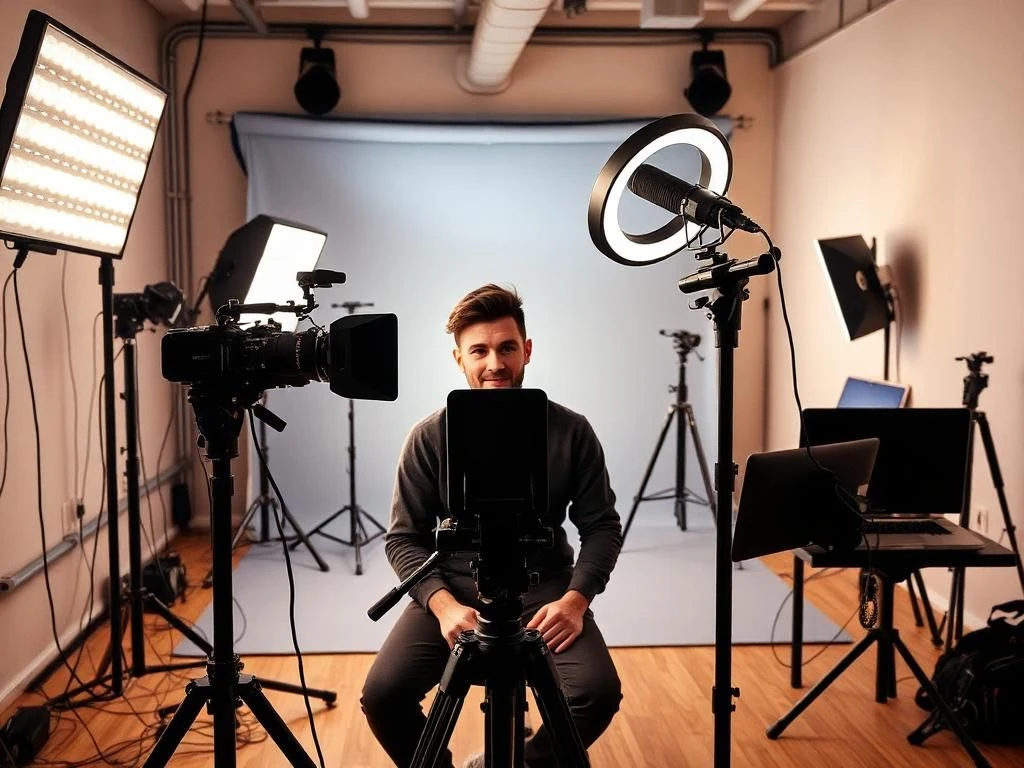
ASIC vs GPU: What Are The Main Differences To Consider
Mining is a popular type of activity in the modern world. More and more users st...

Arranging a video studio is a responsible task that deserves thorough consideration and planning. A professional studio is a system of 3 key components, namely equipment (light, sound, and background), placement of cameras, and space organization, are essential.
Below, we’re going to delve into the issue and explain how to build a video production studio. Experts will reveal all the subtleties so that a reader will be able to assemble a studio to fit their budget after reading. So, you’ll find a comprehensible guide on essential steps for arranging such studios.
Due to the specifics of use and production, a video studio requires high-quality lighting, sound, and a background. For lighting, the following devices are used to arrange a full-fledged studio:
This equipment for video studio allows for the creation of the right lighting in a room and ensures the desired effect during shooting.
To shoot videos, users also need sound equipment. There are several types of microphones. The main ones include:
The use of microphones is important to get clear sound without noise. A wide variety of options allows for picking a suitable option for any case.
And finally, it’s necessary to think about and arrange the background. For this aspect, the following solutions are offered:
Background is also crucial since it creates an overall image and affects viewers’ impression. High-quality background contributes to the demonstration of high reputation and deep expertise of speakers.
Although equipment is an indispensable element, space organization is another important aspect when considering how to set up a home studio for video. Most commonly, the majority of video studios face similar problems, namely, cable chaos, overloaded power outlets, scattered equipment, and general maintenance difficulties. This happens due to negligence to space organization and poor order.
However, such negligence can lead to nasty consequences, such as tripping hazards, accidental unplugging during recording, signal interference, inefficient workflow, and an unprofessional working environment. For example, someone might accidentally trip over the wire and tear it, causing system malfunction.
To avoid such nasty problems, it’s important to keep all the devices and connecting accessories in order. Keeping the space neat not only prevents equipment and wires and breaking but optimizes space and improves room ergonomics. Specialized furniture is used to accommodate equipment for video studio and supplementary accessories. Such furniture can house switches, UPS, audio interfaces, patch panels, storage systems. Manufacturers produce diverse models with varying enclosures to satisfy the demands of all customers. The most popular models include:
These models are spacious enough to accommodate the needed hardware, which is why many users prefer them. Select a suitable option, depending on the number of housed devices and accessories to ensure the perfect fit.
Now, let’s move on to video studio essentials and discuss which video formats the equipment is best suited for. We’re going to consider smartphones, mirrorless cameras, and professional cameras.
Advantages include:
Best video formats for smartphones are everyday videos, vlogs, short clips for social media (TikTok, Instagram Reels), and home videos.
Advantages include:
They are best for cinematic videos for YouTube, short films, and vlogs with higher image quality.
Advantages include:
This equipment is best for professional films, commercials, documentaries, music videos, and other projects where maximum technical and artistic excellence is essential.
To sum up, the main advantages of smartphones are their compact size and convenience for everyday shooting. Mirrorless cameras offer image quality and flexibility, but are also bulkier. Professional cameras are suitable for high-quality video, offer a wide range of tools, and can be adapted to complex tasks, although they require more experience and investment.
A video and audio recording studio requires accessories such as tripods for stabilizing equipment, storage systems for saving projects, and power supplies for all devices. Tripods come in various types and are designed to secure microphones, cameras, and lighting equipment. Storage systems can include hard drives, SSDs, and network-attached storage (NAS) for secure storage and backup of large amounts of data. Power supplies, such as surge protectors and surge protectors, are essential for protecting equipment from power surges and ensuring stable operation.
So, here you know how to build a video recording studio. As we’ve found out, the process is responsible and requires attention. Note that it’s important to stick to a phased approach when selecting equipment for a video and audio studio, as well as organizing the technology. This strategy allows for eliminating the risk of making common mistakes and ensures high-quality results with ergonomic setups.

Mining is a popular type of activity in the modern world. More and more users st...

Data center infrastructure is crucial for ensuring reliability and operational e...

Arranging a video studio is a responsible task that deserves thorough considerat...